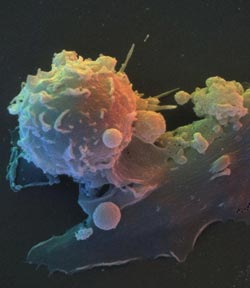Allergy Molecule Identified

The intimate interplay between two cell types of the immune system, dendritic cells (larger cells) and and T cells (white smaller surrounding cells) that play a central role in orchestrating finely balanced immune responses.
There is currently no way to treat food allergy and the only way for sufferers to manage the problem is to avoid certain foods and make sure they have injectable adrenaline at hand.
Scientists led by Dr Claudio Nicoletti at the Institute of Food Research in Norwich have found that a molecule called Interleukin-12 (IL-12) is absent during allergic responses. Dr Nicoletti suggests that by delivering an allergen in the presence of IL-12, allergic reactions could be brought back under control.
“A food protein can be perfectly harmless to one person and lethal to another, said Dr Nicoletti. “We have identified the missing molecule that normally keeps immune responses under control and appropriate.”
Having a food allergy means that the immune system responds to a food protein as if it was harmful. The immune system produces immunoglobulin E (IgE) antibodies, which normally help the body fight parasites. In the most severe cases individuals can suffer life-threatening reactions, including anaphylactic shock.
In previous research, Dr Nicoletti found that special types of white blood cells called dendritic cells are important in helping the immune system decide on how to respond to foreign molecules. In the latest research, Dr Nicoletti compared the activity of dendritic cells in the gut and in the spleen of allergic and allergy resistant mice. He found that in the gut of susceptible mice, dendritic cells have stopped producing IL-12.
This research was carried out in collaboration with the University of Siena.
“We have identified a molecule that is very important for the regulation of immune response and for the first time clearly represents a potential target for the therapy of allergy. This is currently under investigation”, said Dr Nicoletti.
David Reading, director of the Anaphylaxis Campaign, said: “Food allergy can place an extremely heavy burden on the families affected. We welcome this research and look forward to further developments.”
Media Contact
More Information:
http://www.ifr.ac.uk/All latest news from the category: Life Sciences and Chemistry
Articles and reports from the Life Sciences and chemistry area deal with applied and basic research into modern biology, chemistry and human medicine.
Valuable information can be found on a range of life sciences fields including bacteriology, biochemistry, bionics, bioinformatics, biophysics, biotechnology, genetics, geobotany, human biology, marine biology, microbiology, molecular biology, cellular biology, zoology, bioinorganic chemistry, microchemistry and environmental chemistry.
Newest articles

Silicon Carbide Innovation Alliance to drive industrial-scale semiconductor work
Known for its ability to withstand extreme environments and high voltages, silicon carbide (SiC) is a semiconducting material made up of silicon and carbon atoms arranged into crystals that is…

New SPECT/CT technique shows impressive biomarker identification
…offers increased access for prostate cancer patients. A novel SPECT/CT acquisition method can accurately detect radiopharmaceutical biodistribution in a convenient manner for prostate cancer patients, opening the door for more…

How 3D printers can give robots a soft touch
Soft skin coverings and touch sensors have emerged as a promising feature for robots that are both safer and more intuitive for human interaction, but they are expensive and difficult…





















